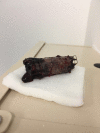Emergency cricothyroidotomy following tracheobronchial stenting
- PMID: 28237950
- PMCID: PMC5337656
- DOI: 10.1136/bcr-2016-218948
Emergency cricothyroidotomy following tracheobronchial stenting
Abstract
A man aged 51 years was referred for tracheobronchial stenting after a poorly differentiated oesophageal carcinoma had progressed to cause stridor. Bronchoscopy revealed a left vocal cord palsy and tumour infiltration into the trachea. A tracheobronchial stent was placed, and after distal migration was endoscopically resited. Returning from theatre, the patient developed severe upper airway obstruction that progressed to cause CO2 narcosis and loss of consciousness. A rapid sequence induction was initiated, and a Glidescope revealed bilateral vocal cord palsy with severe oedema causing an inability to pass a tube or stylet. Tracheostomy was attempted above the suprasternal notch but was obstructed by the stent. Oxygen saturations dropped steadily, reaching as low as 38%. Emergency cricothyroidotomy was performed, compliant with DAS guidelines, that proved successful. The stent was removed, which was blocked with blood and secretions, and tracheostomy was placed 2 days later. The patient made a full neurological recovery.
2017 BMJ Publishing Group Ltd.
Conflict of interest statement
Figures
References
Publication types
MeSH terms
LinkOut - more resources
Full Text Sources
Other Literature Sources
Medical

